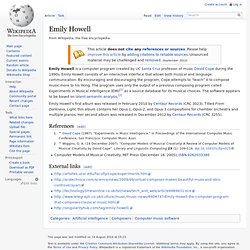

TIL there was a song written in the 1630s that was performed only in the Sistine Chapel. The Vatican kept the composition of the piece secret for 150 years until the 14-year-old Mozart listened to the piece two times, transcribed it from memory, and produ. Miserere (Allegri) Miserere (full title: Miserere mei, Deus, Latin for "Have mercy on me, O God") is a setting of Psalm 51 (50) by Italian composer Gregorio Allegri.

It was composed during the reign of Pope Urban VIII, probably during the 1630s, for use in the Sistine Chapel during matins, as part of the exclusive Tenebrae service on Holy Wednesday and Good Friday of Holy Week. The Miserere is written for two choirs, one of five and one of four voices, and is an example of Renaissance polyphony surviving to the present day. Listen to the Oldest Song in the World: A Sumerian Hymn Written 3,400 Years Ago. In the early 1950s, archaeologists unearthed several clay tablets from the 14th century B.C.E..

Found, WFMU tells us, “in the ancient Syrian city of Ugarit,” these tablets “contained cuneiform signs in the hurrian language," which turned out to be the oldest known piece of music ever discovered, a 3,400 year-old cult hymn. Anne Draffkorn Kilmer, professor of Assyriology at the University of California, produced the interpretation above in 1972. (She describes how she arrived at the musical notation—in some technical detail—in this interview.) Since her initial publications in the 60s on the ancient Sumerian tablets and the musical theory found within, other scholars of the ancient world have published their own versions. The piece, writes Richard Fink in a 1988 Archeologia Musicalis article, confirms a theory that “the 7-note diatonic scale as well as harmony existed 3,400 years ago.”
Via WFMU. Every Noise at Once. Italian progressive metal deep symphonic black metal christian symphonic metal brazilian classical piano native american spiritual indonesian alternative rock romanian contemporary classical greek contemporary classical classic progressive house vintage italian soundtrack japanese progressive house novos talentos brasileiros melbourne bounce international south african alternative. A Retromatic History of Music (or Love) Genres by Country. The Minstrel Boy. The song gained widespread popularity and became a favourite of many Irishmen who fought during the American Civil War and gained even more popularity after World War I.

The song is notably associated with organisations that historically had a heavy representation of Irish-Americans, in particular the police and fire departments of New York, Boston and Chicago and those of various other major US metropolitan areas, even after those organisations have ceased to have a substantial over-representation of personnel of Irish ancestry.
The melody is frequently played at funerals of members and/or officers of such organisations who have died or been killed in service, typically on bagpipes. Unsurprisingly, given its lyrics, it is also associated with the Irish Army and with traditionally Irish regiments in the British, United States and other armies. Lyrics[edit] The original lyrics are as follows: A concentrated, single verse version exists: Notable performances and recordings[edit] Emily Doesn’t Care If You Listen. “Cope remembered that Bach wasn’t a machine—once in a while, he broke his rules for the sake of aesthetics.

The program didn’t break any rules; Cope hadn’t asked it to.” —Ryan Blitstein, “Triumph of the Cyborg Composer,” Miller-McCune, February 22, 2010. Technology evolves at such a fast pace that it is often difficult to discuss a new innovation critically without fearing that the argument will be anachronistic before the discussion is even complete. Emily Howell. Emily Howell is a computer program created by UC Santa Cruz professor of music David Cope during the 1990s.

Emily Howell consists of an interactive interface that allows both musical and language communication. By encouraging and discouraging the program, Cope attempts to “teach” it to compose music more to his liking. The program uses only the output of a previous composing program called Experiments in Musical Intelligence (EMI)[1] as a source database for its musical choices. The software appears to be based on latent semantic analysis.[2] Emily Howell’s first album was released in February 2010 by Centaur Records (CRC 3023). References[edit] Main. Why not develop music in ways unknown? This only makes sense. I cannot understand the difference between my notes on paper and other notes on paper. If beauty is present, it is present. I hope I can continue to create notes and that these notes will have beauty for some others. I am not sad. Emily Howell is a computer program created by David Cope during the 1990s. Dr Cope My name is Jenna Mattox, and I am a freshman at Nazareth College of Rochester.
From Darkness, Light (Opus 1): Two Pianos 20:57. Watch Between the Lines: The Beatles. INTERACTIVE MASHUP: Common Meter with Helen Arney and Jay Foreman. Listen to 2,500-year-old music brought back to life. Listen to performances of the world's oldest complete surviving song. These Astronomical Clocks Were a Wonder of the Medieval World. Extra Credits – Video Game Music. Music Movies Shorty: The Music of Persona 3.